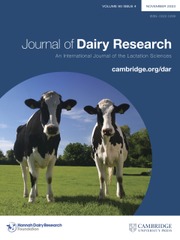No CrossRef data available.
Article contents
Evaluation of a nutraceutical additive on health and growth of preweaned dairy calves
Published online by Cambridge University Press: 28 October 2025
Abstract
This research article aimed to evaluate the effect of a commercial nutraceutical additive in milk replacer on the health and weight gain of dairy calves during the pre-weaning phase. A total of 126 female Holstein calves were randomly assigned to two groups: a treatment group (TRT, n = 63) receiving a commercial nutraceutical additive in the milk replacer, and a control group (CON, n = 63) receiving only the milk replacer. Health assessments included clinical diagnosis, Wisconsin scores and lung ultrasonography to assess the incidence and severity of respiratory and enteric diseases, as well as the average daily gain (ADG). The TRT group showed a reduction in the number of antibiotic treatments for respiratory diseases compared to the CON group. However, calves in the TRT group exhibited greater lung consolidation scores at 75 days of age and lower odds of recovery from pulmonary lesions. No differences were observed between groups in ADG and weaning weight. Additionally, the use of the product did not reduce the incidence or severity of diarrhoea. In fact, calves in the TRT group experienced the first episode of diarrhoea earlier than those in the CON group. These findings indicate that the nutraceutical additive did not contribute to improved enteric or respiratory health. Under real farm conditions, the use of the applied nutraceutical does not consistently lead to beneficial or additive effects across health parameters. These results underscore the importance of context-specific evaluation, as well as the consideration that formulation and environmental factors can significantly influence the outcomes of such interventions.
Information
- Type
- Research Article
- Information
- Copyright
- © The Author(s), 2025. Published by Cambridge University Press on behalf of Hannah Dairy Research Foundation.
Footnotes
These authors contributed equally to this work.

